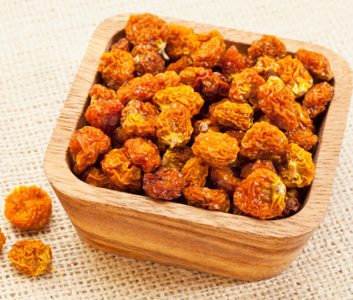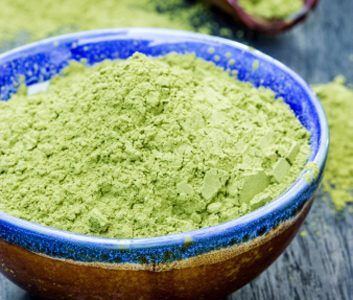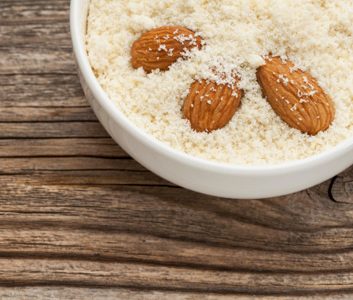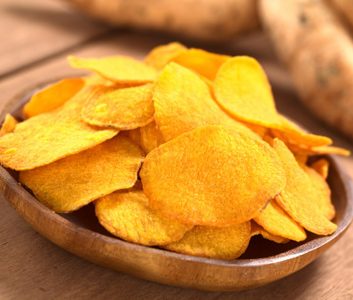
Old fave: Raisins, New fave: Goldenberries
Why goldenberries are so great:
While raisins are a good source of blood-pressure-lowering potassium, chewy goldenberries will help you load up on vitamin A, which can bolster the health of your eyes, immune system, bones and skin. And preliminary research suggests they are a source of withanolides, steroid-like substances believed to have anti-cancer activity. Orange-tinged goldenberries, also known as Incan berries or Cape gooseberries, have a sweet and tart citrusy flavour. Native to South America, most goldenberries destined for North America are dried for transportation and storage purposes; they resemble a raisin in texture and shape. Look for dried goldenberries that are not sweetened with additional sugars.
How to enjoy them:
Grab a handful straight out of the package, or toss them into oatmeal, yogurt, trail mix, salads and baked goods. Brighten up smoothies by softening dried goldenberries in water and blending them with the other ingredients.
Where to find them:
Health food stores and some well-stocked bulk sections of grocery stores.

Old fave: Halibut, New fave: Sablefish
Why sablefish is so great:
Sablefish (often called black cod) has a delicate, flaky texture and a sweet, buttery flavour that will have you hooked. It has slightly less protein than halibut, but three times the omega-3 fatty acids. Higher intakes of these fats have been shown to fight depression as well as inflammation associated with heart disease. It’s recommended we consume an average of 250 to 500 milligrams of omega-3s per day. A three-ounce (90-g) serving of sablefish-about the size of a chequebook-delivers nearly 1,400 milligrams. The Vancouver Aquarium conservation program Ocean Wise gives sablefish sourced off of Canada’s west coast high marks for being a sustainable choice, due to its healthy population numbers in the wild and the non-destructive methods used to catch it. (When buying halibut, Ocean Wise recommends choosing those farmed from Atlantic Canada or wild from British Columbia.)
How to enjoy it:
Similar to other white-fleshed fish such as halibut, sablefish fillets can be steamed, broiled, poached, roasted, seared or grilled. Try it with glazes, marinades, spice rubs and salsas.
Where to find it:
Fishmongers and supermarkets are most likely to sell sablefish as frozen fillets.

Old fave: Regular green tea, New fave: Matcha
Why matcha is so great:
Matcha, the star of the centuries-old Japanese tea ceremony, is made by lightly steaming tea leaves, air-drying them and then stone-grinding them into a very fine green powder. It has been billed as more powerful than regular green tea because when you drink matcha, you are consuming the entire leaf instead of steeping the leaves and then discarding them. This means you benefit from a huge dose of green tea’s age-avenging antioxidants. A 2003 University of Colorado study found that matcha contains up to 137 times more antioxidants than traditional green tea. The best brands have a fresh, sweet scent and a light grassy taste; a strong, bitter flavour is an indication of poor quality.
How to enjoy it:
To make a matcha drink, briskly whisk a teaspoon (5 mL) of the powder with a small amount of almost-boiling water until frothy; then add additional hot water to taste. Or mix with steamed milk for a latte. You can also add matcha to smoothies, oatmeal, salad dressings, homemade ice cream, and muffin or cookie recipes. Or sprinkle it on popcorn with some cayenne pepper.
Where to find it:
Well-stocked tea shops and an increasing number of health food stores.

Old fave: Whole-wheat flour, New fave: Almond flour
Why almond flour is so great:
In terms of vitamins, minerals and fibre, whole-wheat flour is a big nutritional step up from white all-purpose flour. But there are now many other healthy flours on the market, including almond. Among the growing legion of gluten-free choices available, rich and buttery-tasting almond flour is produced from skinless blanched almonds that have been ground into a fine powder. Nutritionally, it outdoes whole-wheat flour in several areas, including having nearly 50 times as much heart-healthy monounsaturated fat, about 33 percent more protein and seven times higher levels of vitamin E (this antioxidant has been linked to better brain functioning and improved hearing). A 2011 study by Purdue University researchers found that including almond flour in a recipe can improve satiety and reduce blood glucose levels, which may help slash weight gain and the risk of diabetes.
How to enjoy it:
Use it to make pancakes, waffles, muffins, dessert breads, cookies, cakes and pie crusts. Try replacing some of the wheat flour in recipes with almond flour for a richer taste. To maintain freshness, store it in the refrigerator or in an airtight bag in the freezer. Bring it back to room temperature before cooking and baking with it.
Where to find it:
Health food stores, bulk stores and some supermarkets. You can also make your own by grinding up skinless almonds using a coffee-bean grinder (a food processor may not give a fine enough consistency).

Old fave: Potato chips, New fave: Sweet-potato chips
Why sweet-potato chips are so great:
Of course, fried potato chips should not be a diet staple, so if you are craving them, choose healthier options such as baked or low-sodium potato chips instead. Better yet, go for baked sweet-potato chips. They’re several times richer in beta-carotene than their potato counterparts. Studies show beta-carotene can help lower the risk of uterus and breast cancers. Scientists believe it behaves as an antioxidant, helping to prevent cell damage that can spiral into cancer. Sweet-potato chips will also give you between one and four more grams of fibre, making them a satisfying snack. You can now find brands without added salt or oils.
How to enjoy them:
Liven up get-togethers by serving sweet-potato chips with salsa or hummus. Also, toss them onto bean salads just before serving, for some pleasant crunch. Better yet: Make your own baked sweet-potato chips.
Where to find them:
Health food stores and most supermarkets.
Related:
• 5 grocery swaps to boost your fibre intake
• Super seeds: 7 types to eat daily
• 7 ways to avoid coffee shop calories
